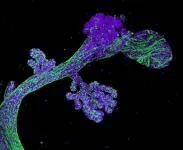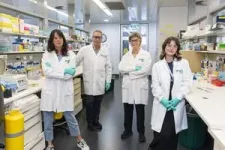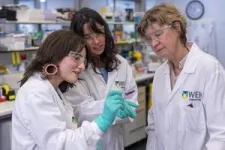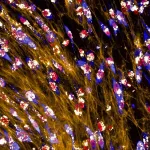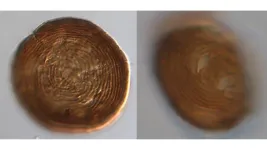(Press-News.org) Australian scientists have pinpointed likely ‘cells-of-origin’, the source cells that can grow into breast cancer, in women carrying a faulty BRCA2 gene who are at high risk of developing the disease.
The WEHI-led study also showed these cells have potential to be targeted with an existing cancer drug to delay tumour growth, in findings that may lead to future preventive treatments for the disease.
At a glance
Women with faulty BRCA2 genes are at a substantially higher risk of developing breast cancer, with 70% of carriers going on to develop the disease, which is often aggressive.
A milestone finding from a WEHI-led research study has pinpointed likely ‘cells-of-origin’ that have the potential to develop into breast cancers in women carrying a faulty BRCA2 gene.
The scientists also uncovered a vulnerability in these cells that they successfully targeted with an existing cancer drug to delay tumour growth in the lab.
Abnormal cells
Women who inherit and carry a faulty BRCA2 gene have a substantially increased risk of developing breast cancer – approximately 70% of carriers will develop the disease over their lifetime.
These cancers often occur at a young age and can be clinically aggressive. Early screening is encouraged and some women undertake preventive breast surgery (mastectomy) to reduce their breast cancer risk.
In a milestone finding published in Nature Cell Biology, researchers have discovered the likely ‘cells-of-origin’ of cancer in BRCA2 carriers. By comparing cancer-free tissue samples from both carriers and non-carriers, they identified an aberrant population of cells that divide more quickly.
Study joint first author Dr Rachel Joyce said this perturbed cell population was found in the majority of tissue samples from women with a faulty BRCA2 gene.
“Given they were found in most of the BRCA2 tissue samples from healthy females, we believe these may be the cells-of-origin that lead to future breast cancers in women that carry the BRCA2 mutation,” Dr Joyce said.
Treatment targets
The aberrant cells in BRCA2 tissue, a subset of breast ductal cells called luminal progenitor cells, stood out to the scientific team because they displayed altered protein production, which is critical for the correct growth and functioning of tissues in our bodies.
“These changes may also make the cells more vulnerable to certain therapies aimed at preventing or delaying breast cancer development,” said study joint first author Dr Rosa Pascual.
Lead author Professor Jane Visvader said the team developed a pre-clinical BRCA2 model that showed similar alterations in the ductal cells, and targeted them with the existing cancer drug everolimus, which is approved to treat patients with relapsed breast cancer.
“Through pinpointing this vulnerability in protein production, we were able to show that pre-treatment with this drug delayed the formation of tumours in the pre-clinical model,” said Prof Visvader, joint head of the ACRF Cancer Biology and Stem Cells Division and the Breast Cancer Laboratory at WEHI.
“This raises the possibility that targeting specific aspects of protein production in this way could represent a new breast cancer prevention strategy for women with a faulty BRCA2 gene.”
Towards prevention
The findings are an important first step towards the goal of preventative treatments for breast cancer in BRCA2-mutation carriers.
Study author and cancer clinician, Professor Geoff Lindeman said that while the findings were exciting, more work was needed before they could be applied in the clinic.
“While everolimus did delay tumour development in the lab, this drug can have side-effects, which might limit its capacity to be used as a preventative treatment," said Prof Lindeman, joint head of the ACRF Cancer Biology and Stem Cells Division at WEHI, and a medical oncologist at the Royal Melbourne Hospital and Peter MacCallum Cancer Centre.
“Our team want to further explore which specific parts of protein processing are dysregulated, and use this information to develop more selective and tolerable preventative treatments.
“There’s still a way to go, but we’re a big step closer.
“A few years ago, we identified the likely cells-of-origin for breast cancer in females carrying a fault in the BRCA1 gene, which is also associated with a high risk of developing breast cancer. That research has since led to an international breast cancer prevention study (BRCA-P).
“We hope that our new findings will now inform future treatment and prevention for women with a faulty BRCA2 gene.”
The study, ‘Identification of aberrant luminal progenitors and mTORC1 as a potential breast cancer prevention target in BRCA2 mutation carriers’, is published in Nature Cell Biology (DOI: 10.1038/s41556-023-01315-5).
The research was carried out on breast tissue samples kindly donated by women undergoing breast surgery, with assistance from the Victorian Cancer Biobank (funded by the Victorian Government) and the Kathleen Cuningham Foundation Consortium for research into Familial Breast cancer. The research was supported by the National Health and Medical Research Council, Breast Cancer Research Foundation, the National Breast Cancer Foundation, The Medical Research Future Fund, the Two Sisters Foundation and the Heine Family.
M: +61 475 751 811
E: communications@wehi.edu.au
About WEHI (Walter and Eliza Hall Institute of Medical Research)
WEHI is where the world’s brightest minds collaborate and innovate to make life-changing scientific discoveries that help people live healthier for longer. Our medical researchers have been serving the community for more than 100 years, making transformative discoveries in cancers, infectious and immune diseases, developmental disorders, and healthy ageing. WEHI brings together diverse and creative people with different experience and expertise to solve some of the world’s most complex health problems. With partners across science, health, government, industry, and philanthropy, we are committed to long-term discovery, collaboration, and translation. At WEHI, we are brighter together.
Find out more at www.wehi.edu.au
END
Study pinpoints breast cancer ‘cells-of-origin’ in high-risk women
2024-01-16
ELSE PRESS RELEASES FROM THIS DATE:
Supports help keep Aussie firefighters safe
2024-01-16
House fires, road crashes and emergency rescues – they’re all part of the job for Aussie firefighters. And in such physically demanding roles, maintaining a high level of fitness and movement quality is essential.
Now, new research from health and fitness experts at the University of South Australia shows that professional firefighters have reduced movement quality as they age, which could put them at greater risk of injury.
Conducted by UniSA masters researcher, Alex Redshaw, in partnership with the South Australian Metropolitan Fire Service (MFS), the findings indicate that firefighters over the age of 50 generally have lower movement ...
Study: New deepfake detector designed to be less biased
2024-01-16
BUFFALO, N.Y. — The image spoke for itself.
University at Buffalo computer scientist and deepfake expert Siwei Lyu created a photo collage out of the hundreds of faces that his detection algorithms had incorrectly classified as fake — and the new composition clearly had a predominantly darker skin tone.
“A detection algorithm’s accuracy should be statistically independent from factors like race,” Lyu says, “but obviously many existing algorithms, including our own, inherit a bias.”
Lyu, PhD, co-director of the UB Center for Information Integrity, and his team have now developed what they believe are the ...
Researchers find that using patients’ own blood, rather than saline, helps preserve veins in coronary bypass grafts
2024-01-16
In a collaboration between the Fralin Biomedical Research Institute at VTC and Carilion Clinic, researchers learned that by preserving large superficial leg veins intended for coronary bypass grafting in a mixture of the anticoagulant heparin and blood, rather than heparin and saline, the veins were better protected from cell and tissue damage.
Their findings, published in January in the Journal of Vascular Research, could inform surgical practices and enhance the long-term success of vein grafts in coronary bypass surgeries.
“Ultimately, we're putting healthier blood vessels ...
What if cows could talk?
2024-01-16
You may not know it, but cows share information every time they burp, moo, and chew that speaks volumes about their health and welfare.
Through the work of researchers in Virginia Tech’s College of Agriculture and Life Sciences, we may soon know more about what cows are “telling” us and be able to use that information to improve their well-being.
James Chen, an animal data sciences researcher and assistant professor in the School of Animal Sciences is using a $650,000 grant from the U.S. Department ...
Allen Fawcett named Director of the Joint Global Change Research Institute
2024-01-16
By Greg Koller
COLLEGE PARK, Md.— Allen Fawcett — an energy expert and economist who has played a leading role in formulating and coordinating U.S. climate policy — is the new director of the Joint Global Change Research Institute.
Fawcett joined the Environmental Protection Agency in 2003 and, since 2012, served as the chief of EPA’s Climate Economics Branch, which advances the science of climate economics to inform policy. From 2010 to 2011, Fawcett took leave from EPA to serve as the deputy associate director for energy ...
Parents more likely to attempt suicide in first years after child’s cancer diagnosis
2024-01-16
Parents who have a child with cancer are more likely to attempt suicide during the first years after diagnosis, according to a new study conducted by Qianwei Liu of Southern Medical University, China, and colleagues, published January 16th in the open access journal PLOS Medicine.
Receiving a cancer diagnosis for a child is an incredibly stressful and distressing experience for parents. These parents, especially mothers, face an increased risk of psychiatric disorders, but little is known about the risk of suicide. In the new study, researchers looked at the number of suicide attempts ...
Energy-starved breast cancer cells consume their surroundings for fuel
2024-01-16
New study from the University of Sheffield identifies a novel mechanism employed by breast cancer cells to survive in the challenging environment within tumours
The findings provide a new insight into a previously unknown mechanism of cancer cell survival and may offer a new target for developing therapies
The research found breast cancer cells take advantage of nutrients in the extracellular matrix in times of nutrient starvation
Energy starved breast cancer cells ingest and consume their surroundings to overcome starvation, a new study has found.
The research, conducted by scientists at the University of Sheffield and published today (Tuesday 16 January ...
How did free wi-fi help unlock Hanoi wet markets’ mysteries?
2024-01-16
Researchers at the Alliance of Bioversity International and CIAT and their collaborators have been working on how to harness the power of the estimated 549 million Wifi hotspots worldwide, resulting in a project that used anonymized data gathered from free Wi-Fi to better understand the impact of COVID-19 on Hanoi’s wet markets during the first stage of the Covid-19 pandemic.
In the paper “Using free Wi-Fi to assess impact of COVID-19 pandemic on traditional wet markets in Hanoi” published in December 2023 in the scientific journal Food Security, the researchers analyzed and interpreted mobile device tracking ...
Smooth operation of future nuclear fusion facilities is a matter of control
2024-01-16
As researchers around the world work to develop viable alternatives to fossil fuels, the prospect of nuclear fusion—harnessing the same energy-generating reactions that power the sun—has grown increasingly attractive to private equity firms.
In 2022, the U.S. Department of Energy launched a partnership with investors in the private sector to accelerate the development of fusion energy, in part through the development of a fusion pilot plant, or FPP, in the United States.
The FPP and ITER—the world’s largest nuclear fusion reactor, currently being ...
Microfossils shed light on the long fossil record of euglenoids
2024-01-16
Hiding in the shadows, euglenoids are a fascinating group of single-celled protists that are neither plant nor animal. Plants photosynthesize, and animals eat. Euglenoids do both. Spiraling along the murky bottoms of shallow fresh-water ponds with their long flagella, they eat organic goop, while also using their chloroplasts to convert CO2 and water with light into sugars. Because of this in-between status, euglenoids have been placed close to the very base of the eukaryotic branch on the tree-of-life that includes ...
